Report

At a Glance
- Despite high workforce participation, fewer women advance to the executive level in China than in other countries.
- There is a strong business case for more women in executive leadership. Gender diversity is linked to improved business processes and outcomes.
- Four barriers stop women from becoming executives: family responsibilities, hesitation, lack of sponsorship, and unconscious biases.
- We propose a clear set of actions that both companies and women can take to increase gender equity and reach their full potential.
The status of women in the workplace
Gender equity at the executive level is a global issue, but it’s more pronounced—and more perplexing—in China. Chinese women are promoted to the executive level less often than Chinese men and less often than women in other countries.
Written in collaboration with
Written in collaboration with

Based on education and workforce participation, Chinese men and women have similar starting lines. Yet they find themselves on divergent career paths. Compared to men, only a small percentage of women in China reach the executive ranks, and women who become executives often lead functional lines. Very few become CEOs (see Figure 1).
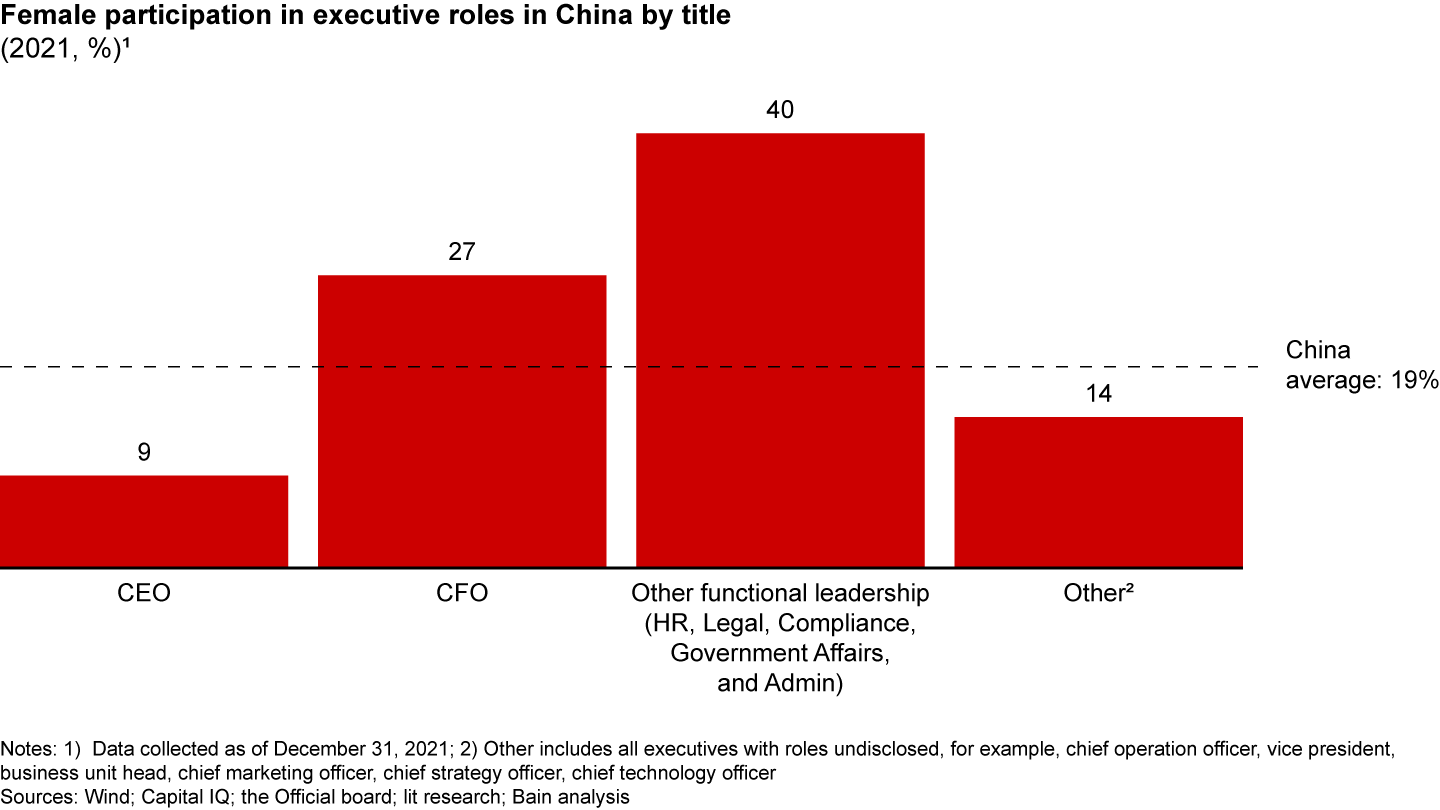
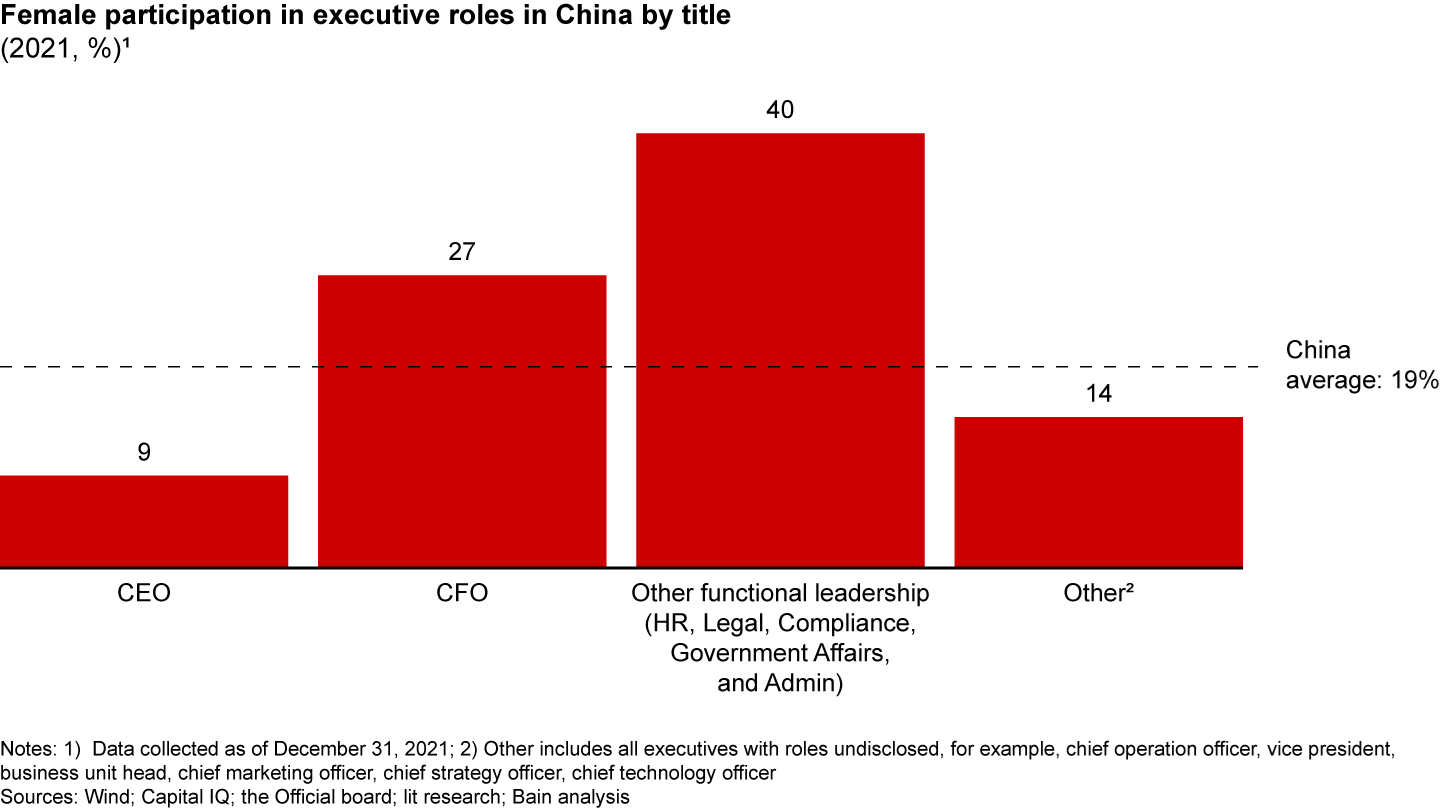
Chinese women fall behind women in other countries too, despite starting their careers on equal or better footing. Their access to higher education has significantly expanded over the past two decades, outpacing other countries. Chinese women also have higher workforce participation than women in other countries (see Figure 2).
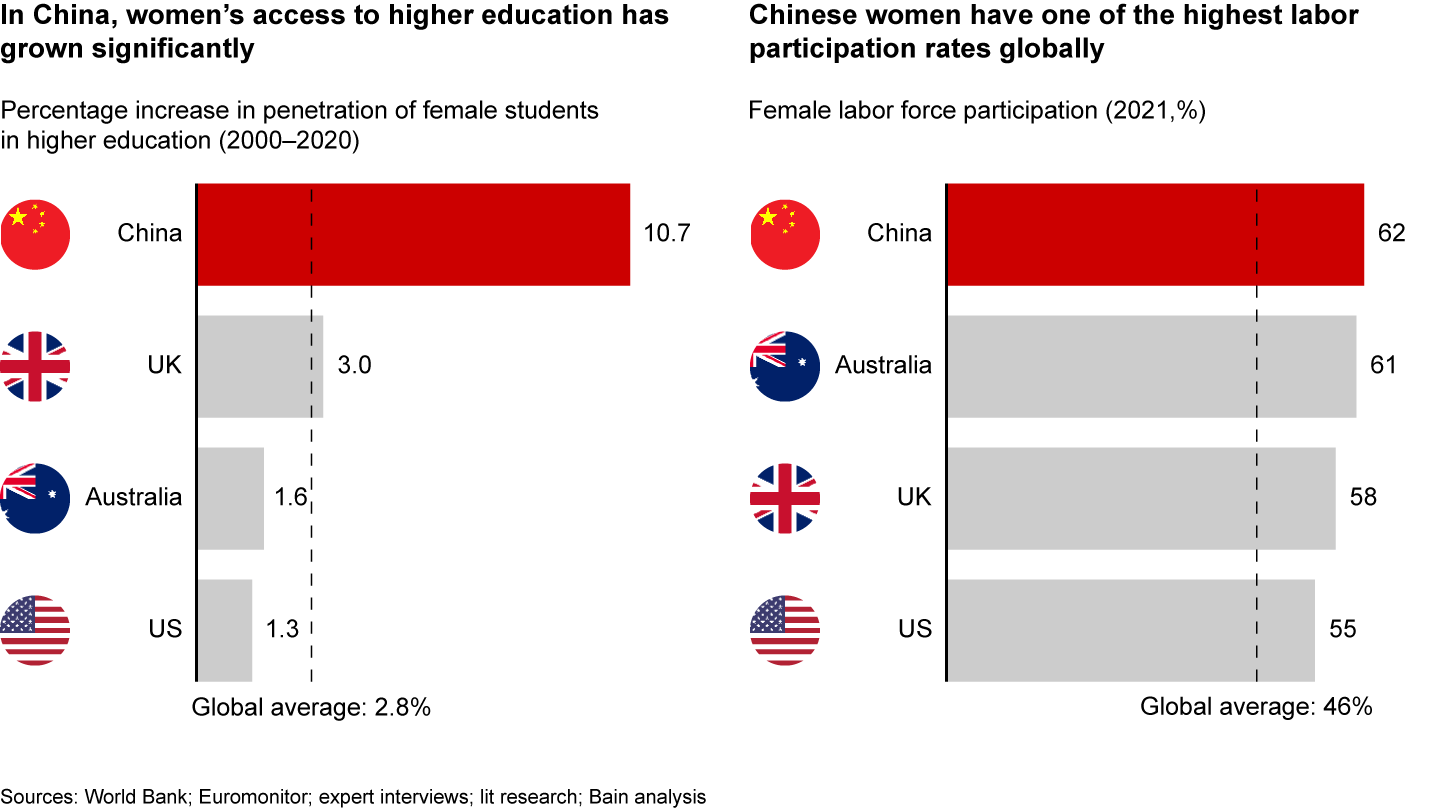
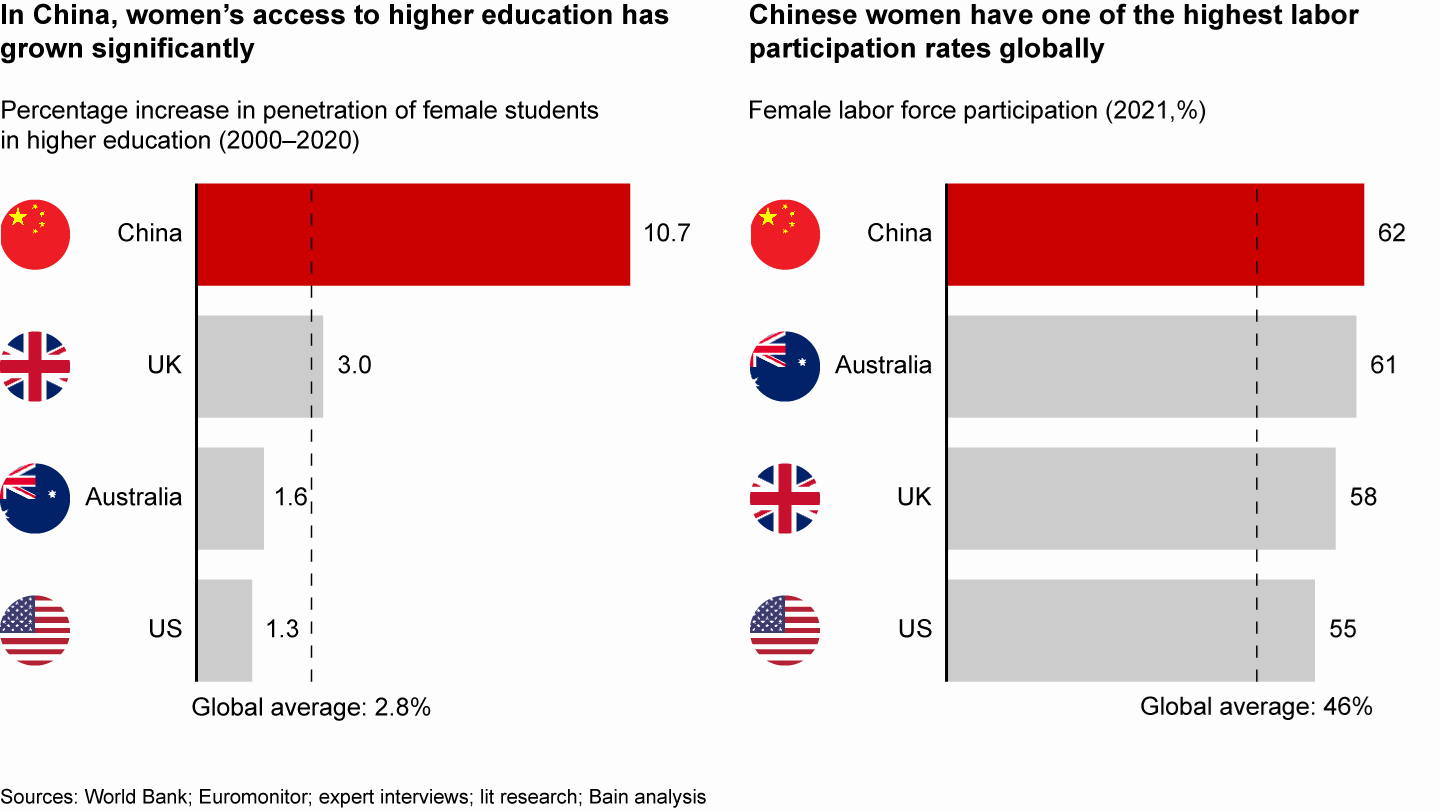
They reach mid-level management at similar rates as women in countries that lead in gender parity. Then, their careers fizzle out (see Figure 3). Only 19% of executives in China are women, compared with about 25% in other countries.
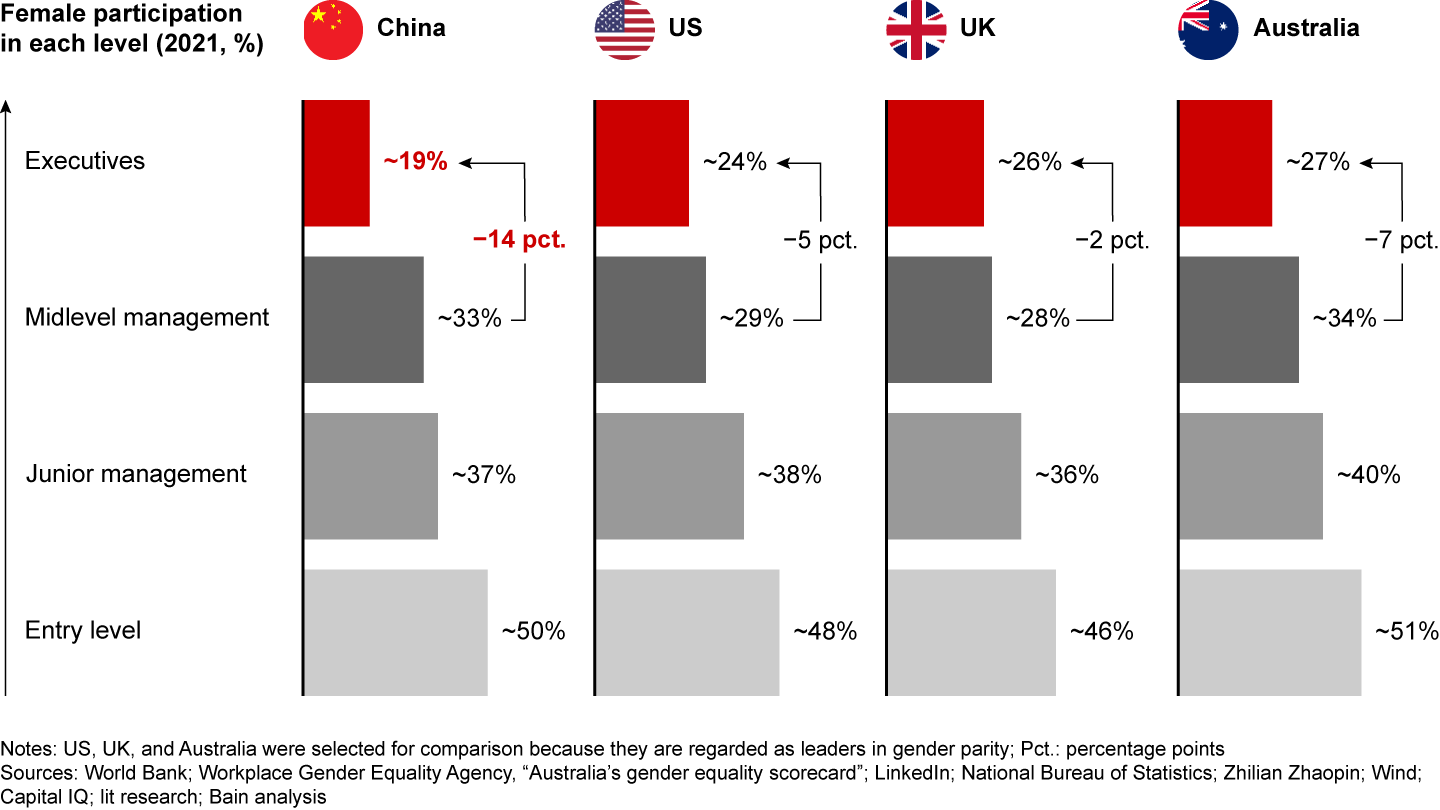
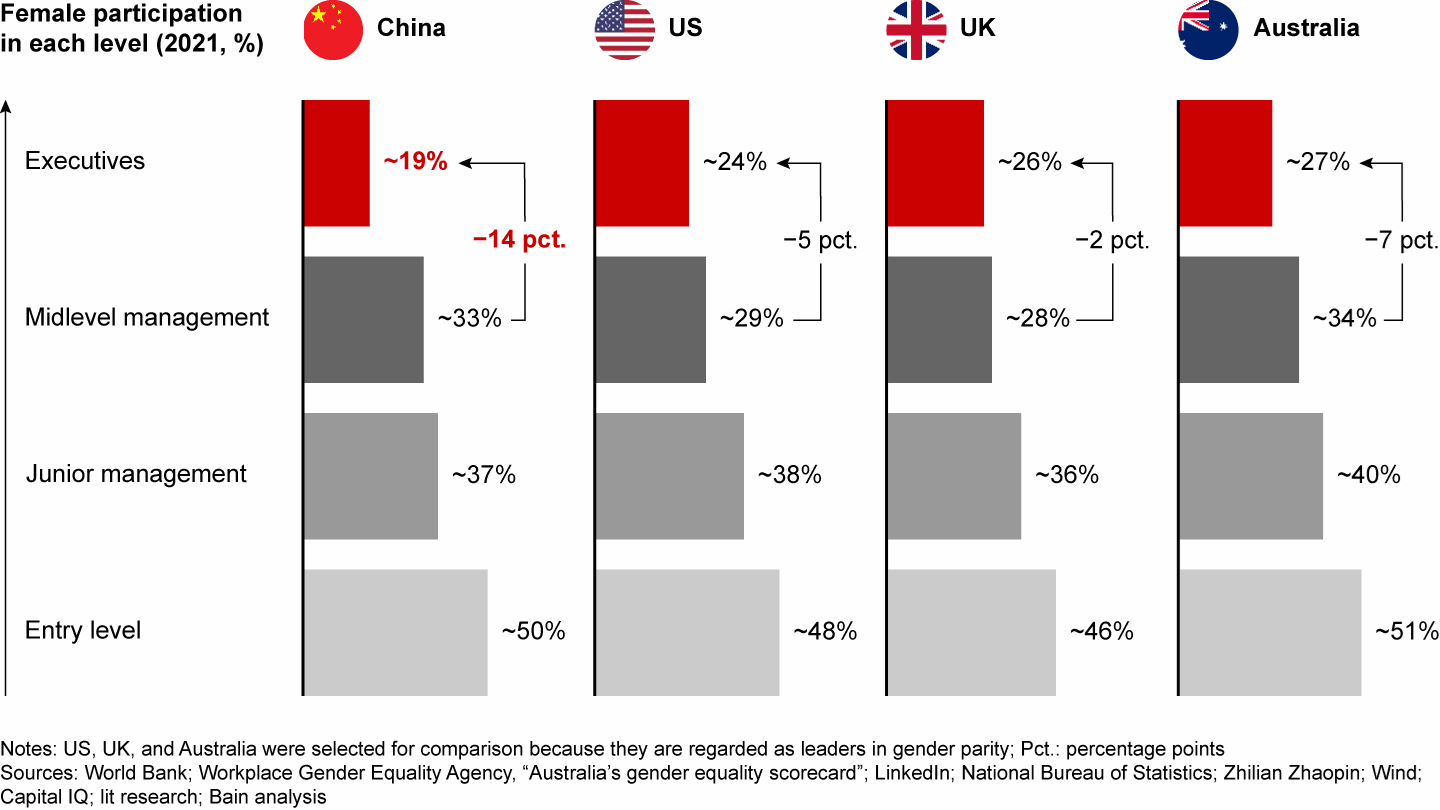
Something is blocking Chinese women’s ascent.
This research explores two questions: how Chinese women get knocked off the trajectory toward executive leadership, and what companies can do to keep them on track.
Why does women’s representation matter?
Women’s representation in executive teams is not a question of being “fair.” It is an important lever for value creation. When women do not rise to their full potential, neither do their companies.
The business benefits of gender diversity in executive teams are well-documented. Having more women on executive teams improves profit and cash flow performance, shareholder returns, and credit ratings, to name only a few benefits (see Figure 4).
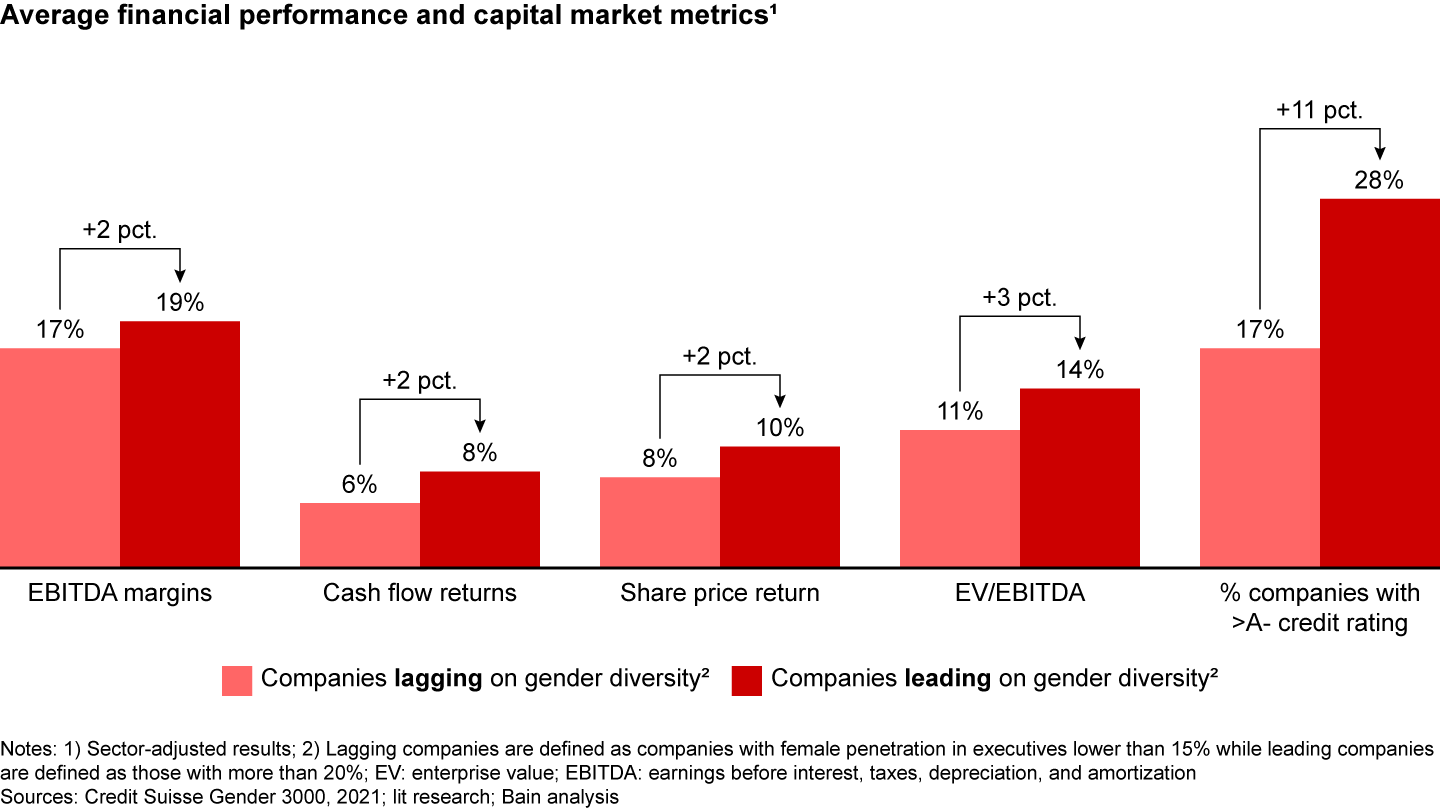
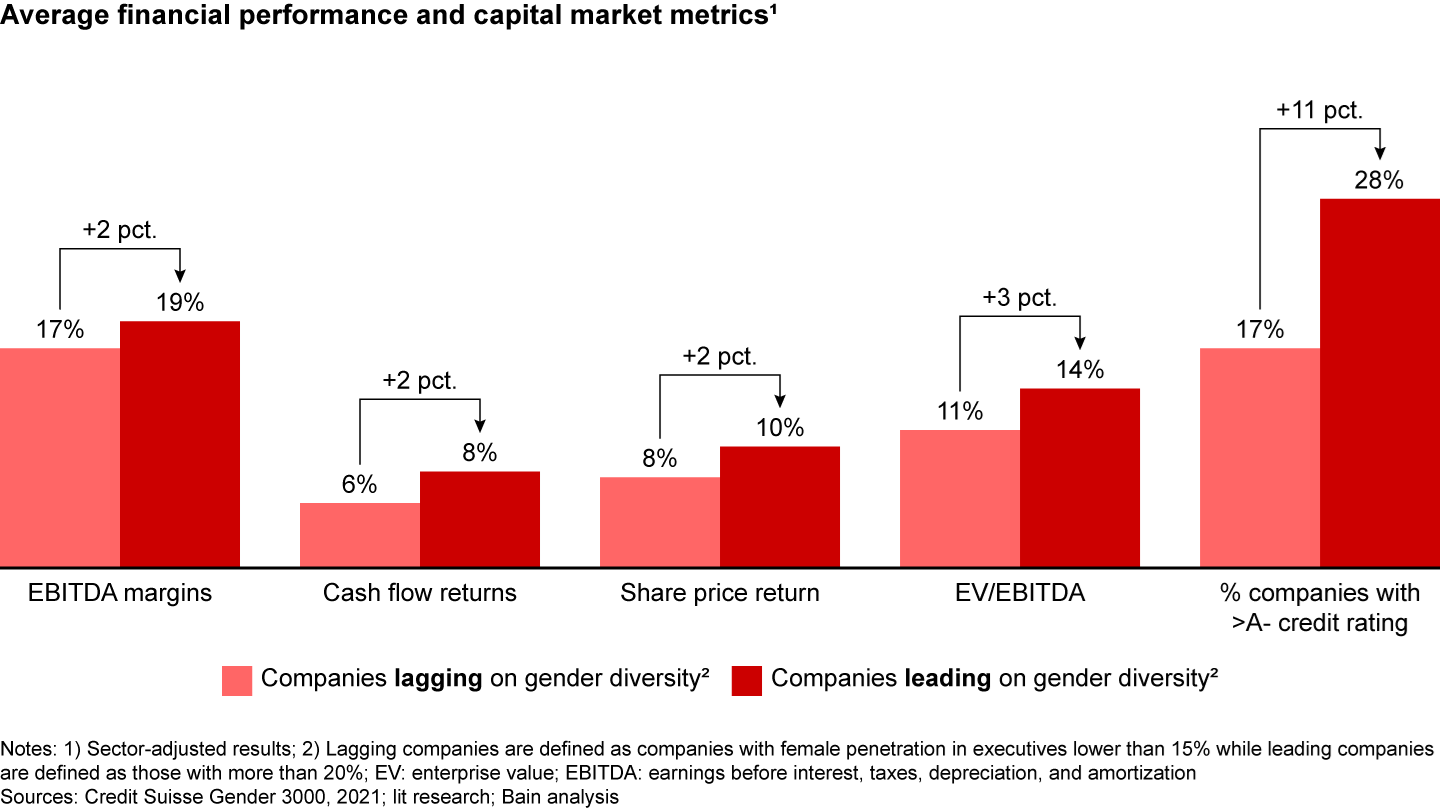
Research proves a causal relationship between the number of women in leadership and improvements in company performance. In Australia, university and government researchers linked actions to improve gender diversity in executive teams directly to an increase in financial performance and market value (see Figure 5).
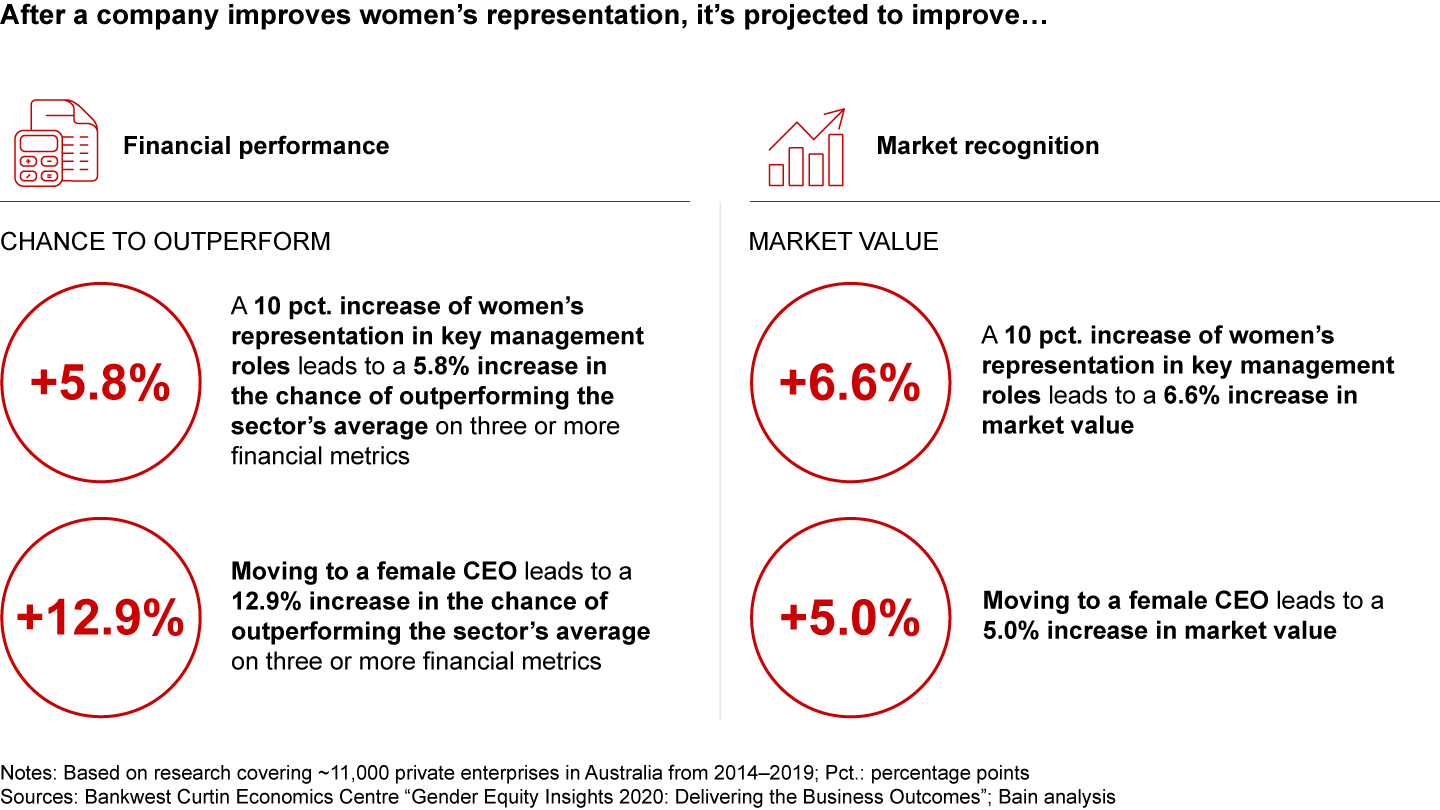
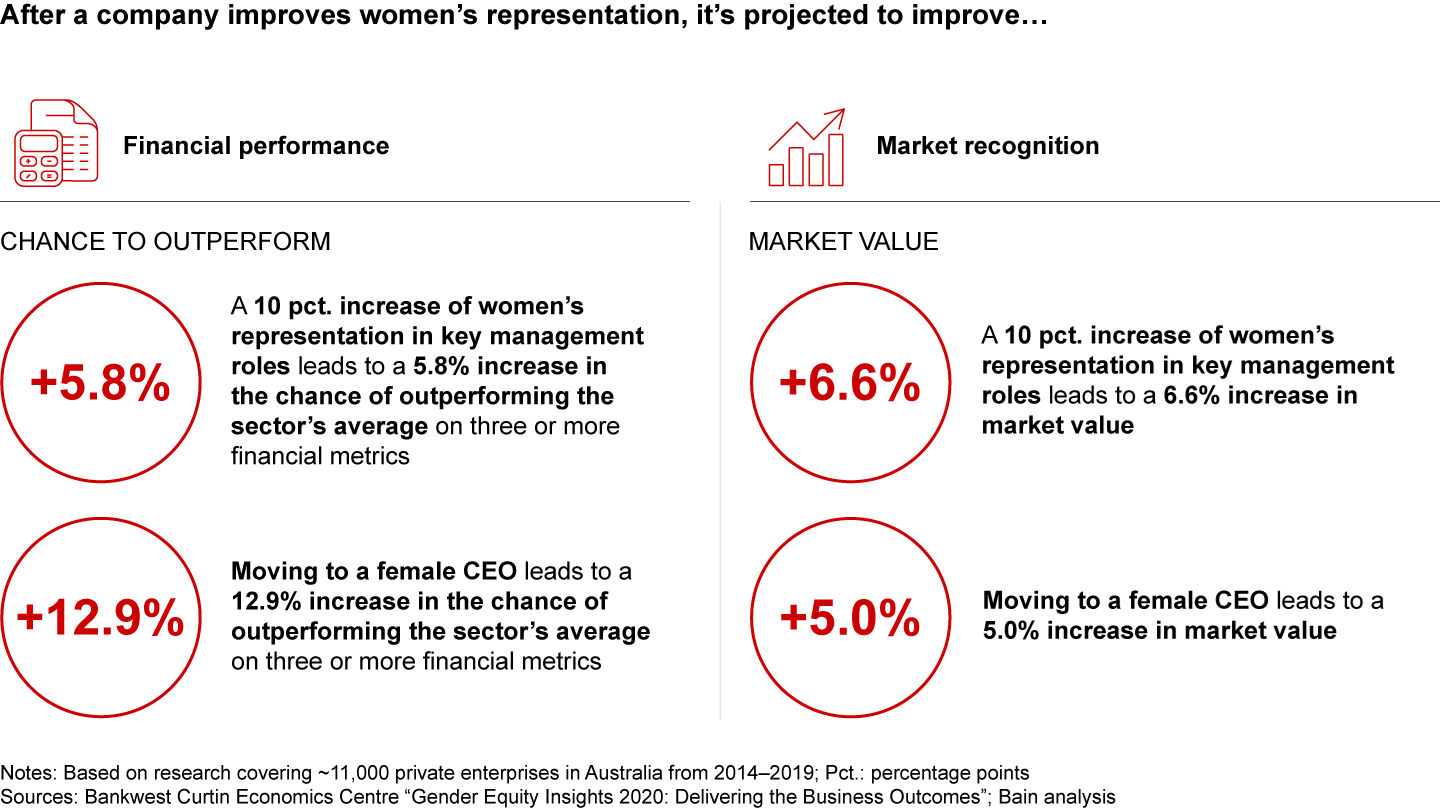
S&P 500 and FTSE 350 firms with female CEOs or gender-balanced leadership teams had a lower probability of default before the Covid-19 pandemic and fared better during the downturn, according to Credit Benchmark. Women leaders are also more likely to drive sustainability agendas and ESG targets, according to The Sustainability Board Report 2021.
The presence of women in executive teams does not magically improve performance. It changes the dynamic of the group, which can mitigate “group think” and improve decision making. Men and women have different backgrounds and life experiences, which foster both inclusion and innovation.
Women leaders may bring deeper empathy and personal experiences to the boardroom, especially when clients and end consumers are predominantly women. At Sephora, Greater China Managing Director Maggie Chan believes female executives can help address their consumers’ pain points and needs.
Gender diversity can also help Chinese employers address a growing talent issue. Eighty-three percent of Chinese employers experienced a talent shortage in 2022, according to a Manpower Group study.
By developing the potential of women, companies in China could alleviate this issue and reach their full potential.
Yet China’s progress toward gender parity is slower than that of other leading countries (see Figure 6). Deliberate action is needed to catch up.
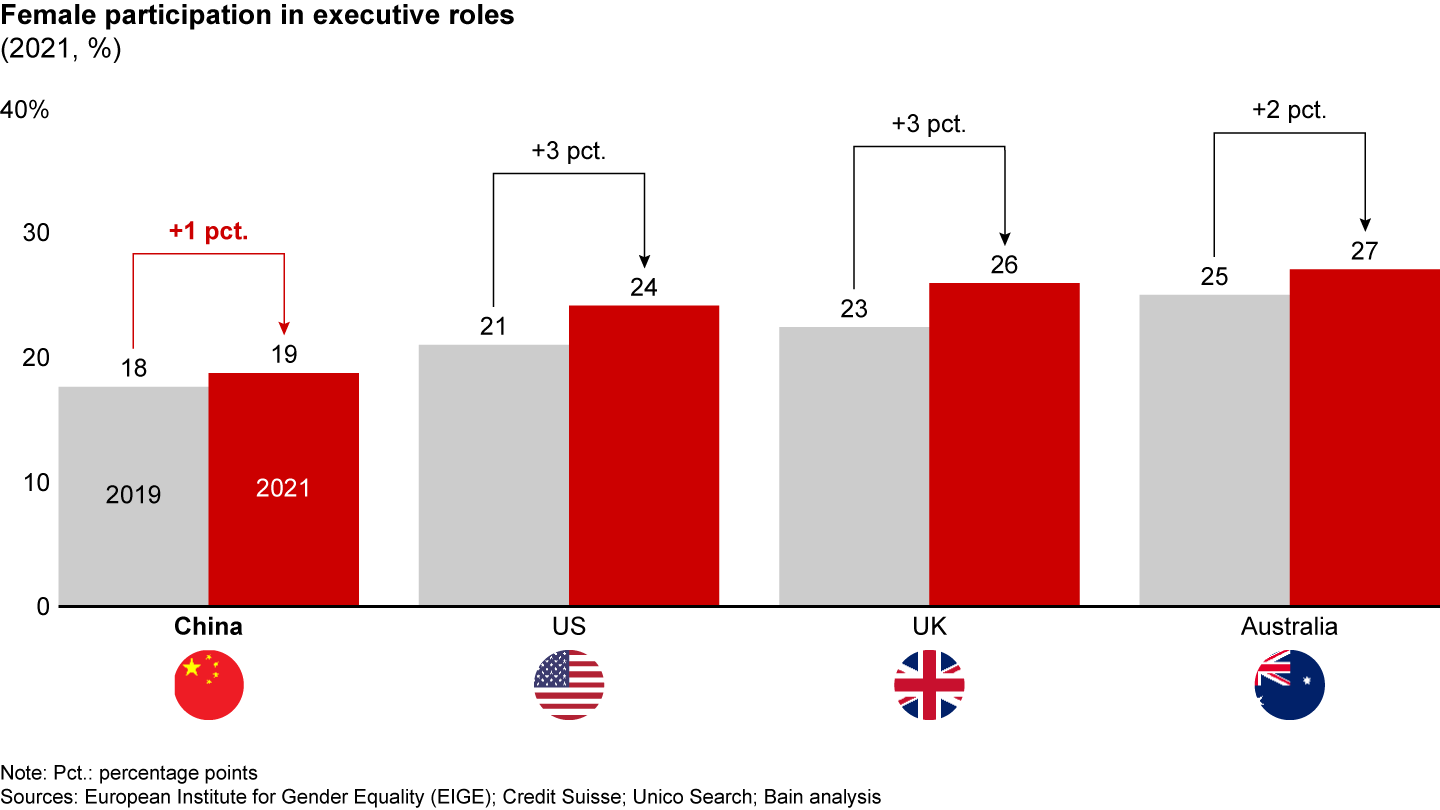
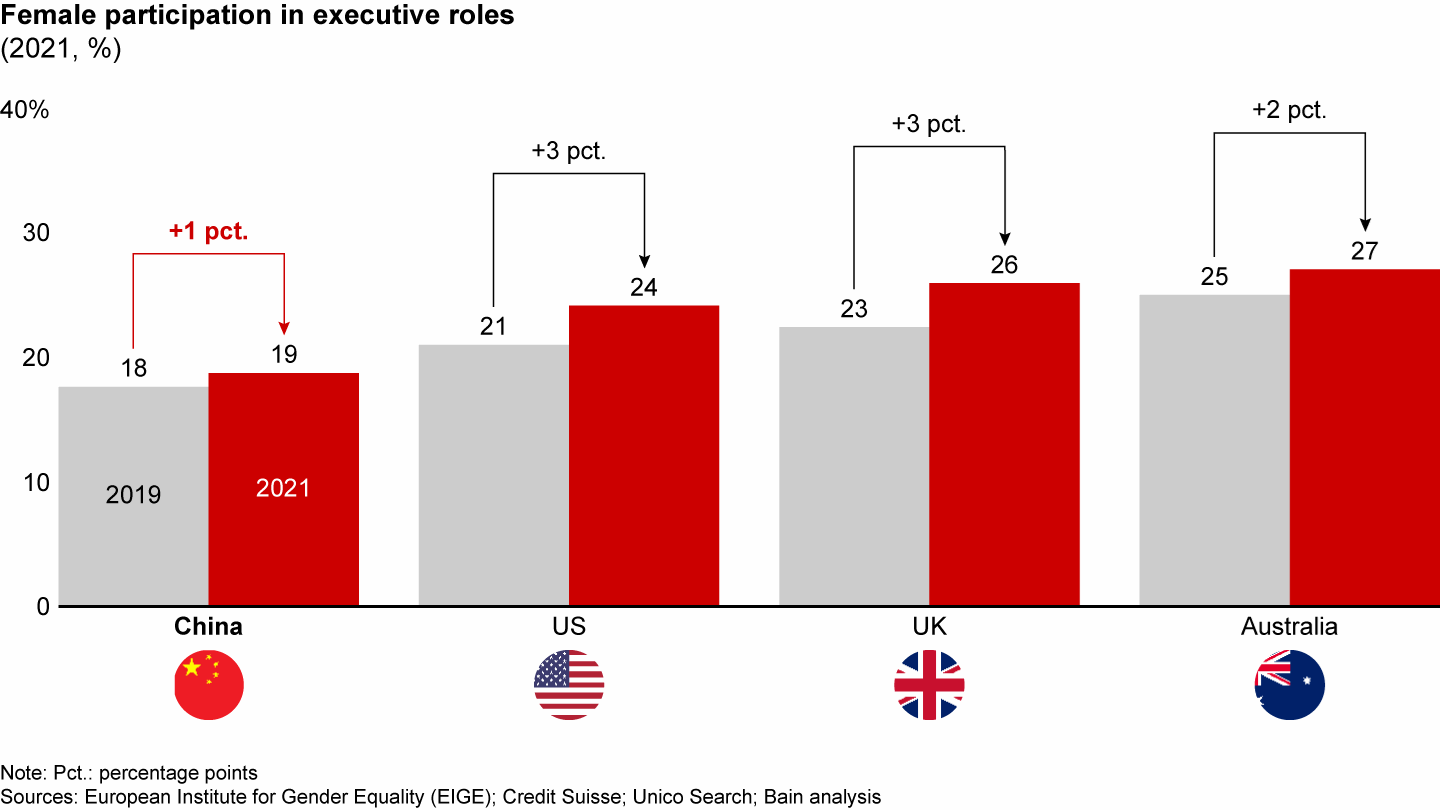
Women can rise to the top
We interviewed about a dozen female executives and surveyed more than 30 female executives, all in China. Our research identified five key drivers and two must-haves that contributed to their success (see Figure 7). These elements helped them demonstrate themselves, earn recognition and sponsorship, and be fully devoted to their careers.
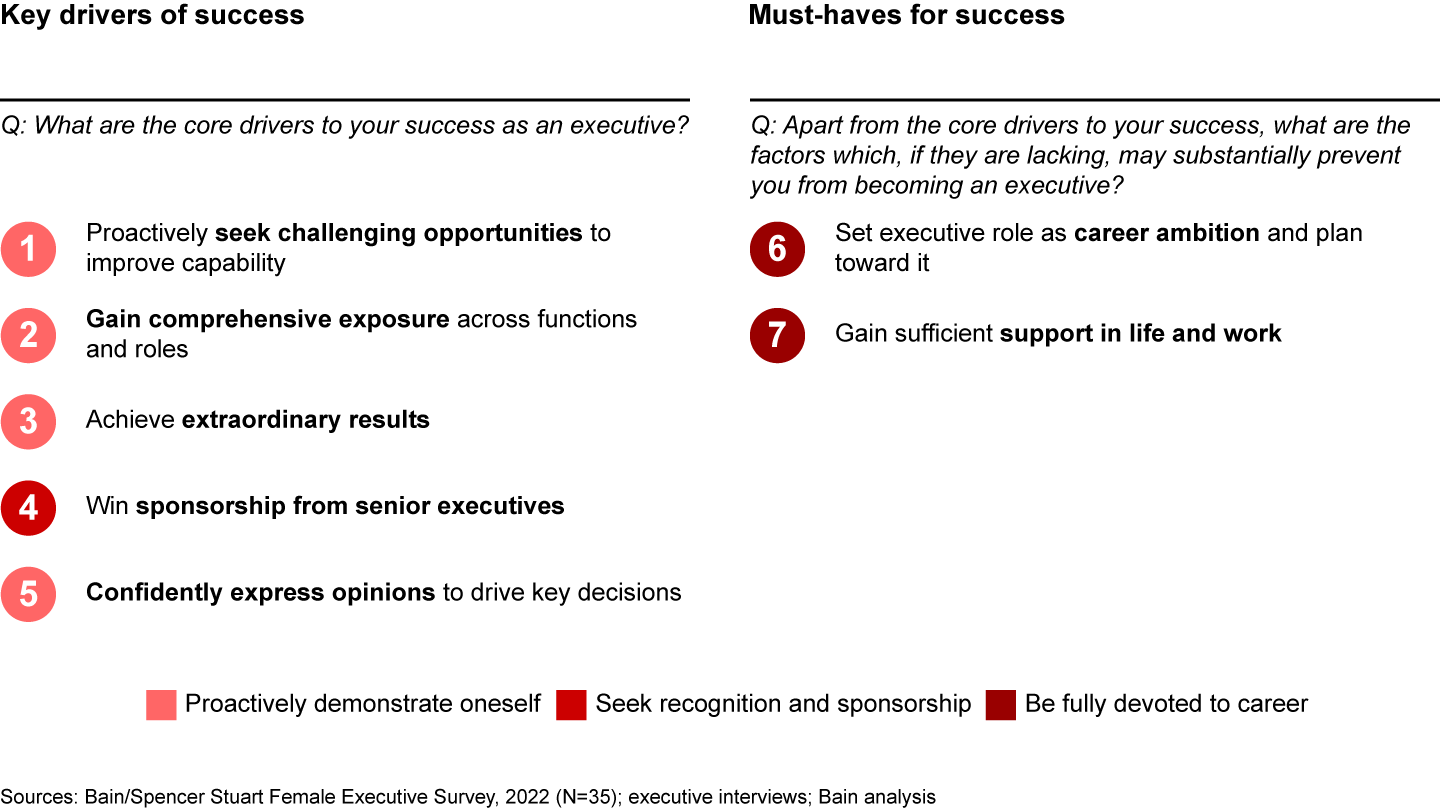
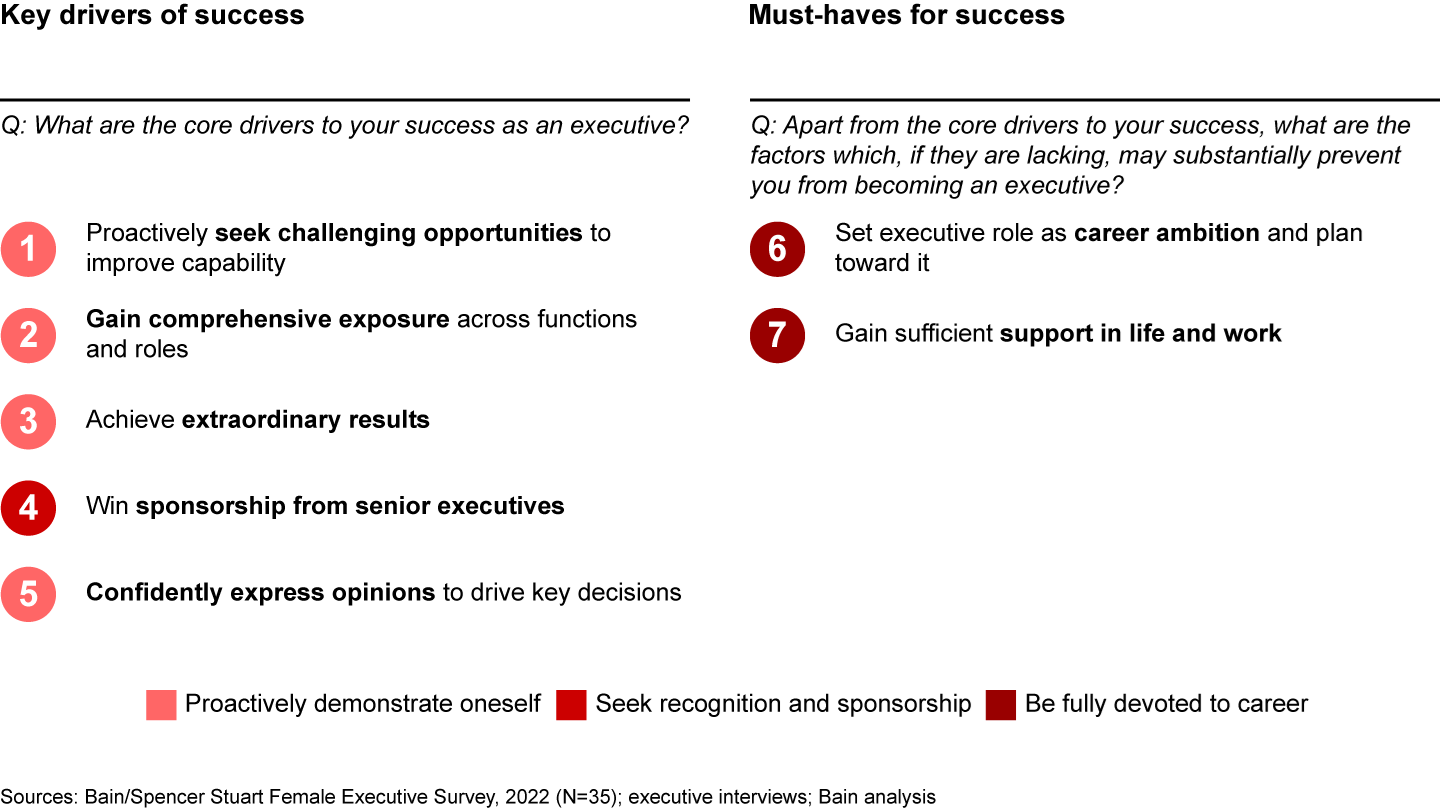
And that is what employers want. “As China is still a developing market, we often hear from employers that they are seeking executive candidates who are fully committed to career … who proactively seize opportunities to break into white space and are skilled at navigating complex stakeholder networks,” said Christina Zhu, co-head of Spencer Stuart’s greater China region. “Just like a hunter who actively searches for prey.
“To some degree, this can present challenges for female candidates,” she said.
Four workplace challenges women face
As executives, the women we spoke to are outliers. But they do not have to be. Companies and women in China can take actions to increase women’s participation in executive teams.
First, they need to recognize common barriers that women face. Based on our interviews and survey, we summarized four challenges that derail women’s career progression:
- Family responsibilities
- Hesitation
- Exclusion from male networks
- Unconscious bias
Challenge 1: Family responsibilities weigh on women more than men
About 83% of the women we surveyed said family duties prevent them from being fully dedicated to work. Over two-thirds of women said their families do not understand their career ambitions.
The idea that “men lead outside and women lead inside” is deeply rooted in Chinese culture, so spouses and children often don’t see that women need full support, sometimes even compromises, from family members to advance and excel at work, according to Zhiqiang Zhang, former managing director of ABB in China. In fact, men are also “looked down upon” in society if they sacrifice their career to support their families and their wives to thrive. This in turn will prevent men from providing full support to their wives in their career development.
Women need more support from their employers, too. More than 70% of respondents said a lack of parental support at work prevents them from advancing their careers.
“I have seen many high-potential women give up professional development opportunities to take care of their families,” said Rachel You, CFO at Jinxin Fertility. “I believe there is much more we can do for them.”
Challenge 2: Women hesitate to speak up and take opportunities
Female executives are more compassionate, empathetic, and cautious, according to a Pew Research Center survey. Those traits have many potential advantages. But they can also hold women back.
Respondents said Chinese women spend more time on major decisions or wait to express their opinions, which can be perceived negatively. More than 80% of respondents said being risk averse or waiting to be well prepared before speaking is a barrier to their advancement.
“Sometimes my female subordinates prefer to wait and not speak up when they have great ideas,” said David Wang, Asia president of Buhler Group, a multinational equipment manufacturer. “We should give them support, even slight pushes, so they will stop hesitating and speak up.”
Women also find it harder to pursue challenging assignments that widen their skill sets. Nearly 60% of women said they hesitate to reach out to senior leaders for opportunities out of fear they’ll make a mistake.
Challenge 3: Women feel excluded from male-dominated networks
On average, women hold only about 19% of executive seats in China. The percentage is even lower in some industries and company types (see Figure 8). Since most leadership circles are composed of men, networking opportunities and social norms are male-dominated and harder for women to break into.
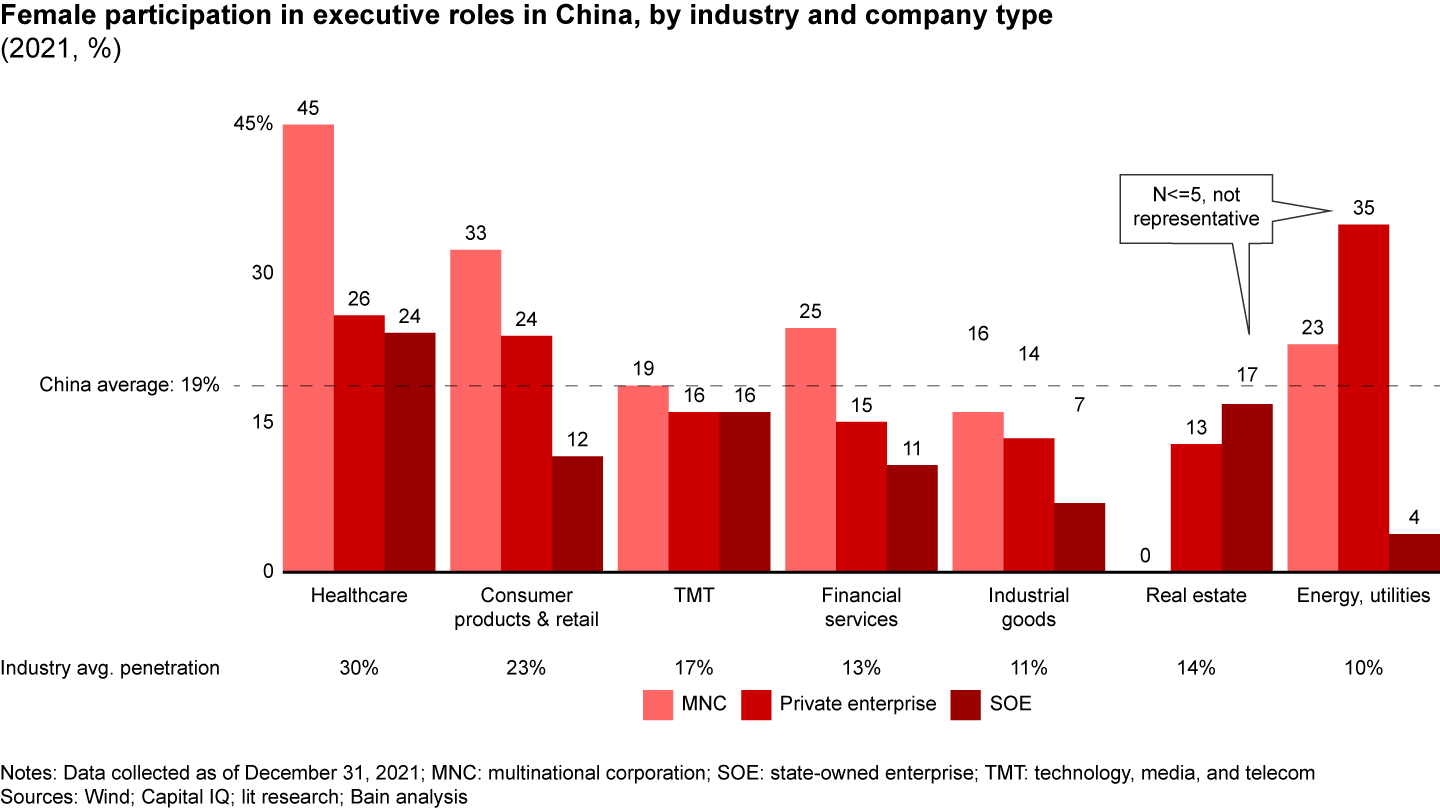
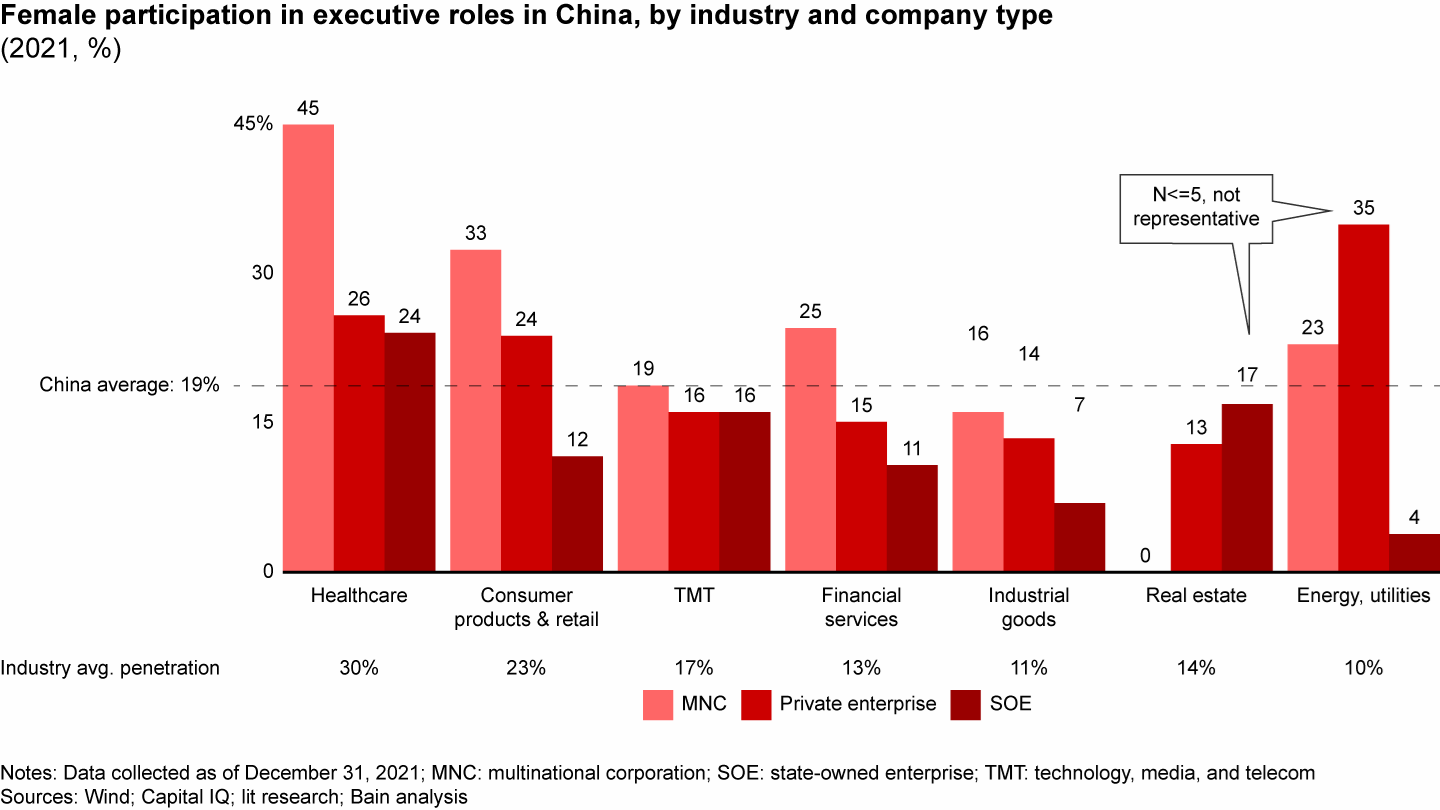
“It was difficult for me to participate in men’s social activities, such as after-work beer or the smoking corner,” said Angela Zhu, former IKEA China CEO, who recalled her experience in Germany. “As a woman, I’m naturally excluded from these activities, or I don’t want to join them.”
Being excluded from social events can shorten women’s careers because it prevents them from gaining sponsorship—which was one of the key drivers cited by female executives. In our survey, about 80% of women said lack of access to executive networks makes it harder to get senior sponsors. More than half said it was more difficult to build high-level connections across the business.
“It is not that easy for women to enter male-dominant networks or social activities. That makes it harder for women to build connections in the workplace, and they need to build their own supporting networks intentionally,” said Xin Tong, PhD, a professor of sociology at Peking University.
Challenge 4: Women are unconsciously biased by an “average” view
Women also face unconscious biases—namely, that all women are “average” and perform the same. In contrast, men are usually recognized by their individual capabilities and characteristics.
According to our research, women in the workplace are perceived as less committed, less confident, and less ambitious (see Figure 9).
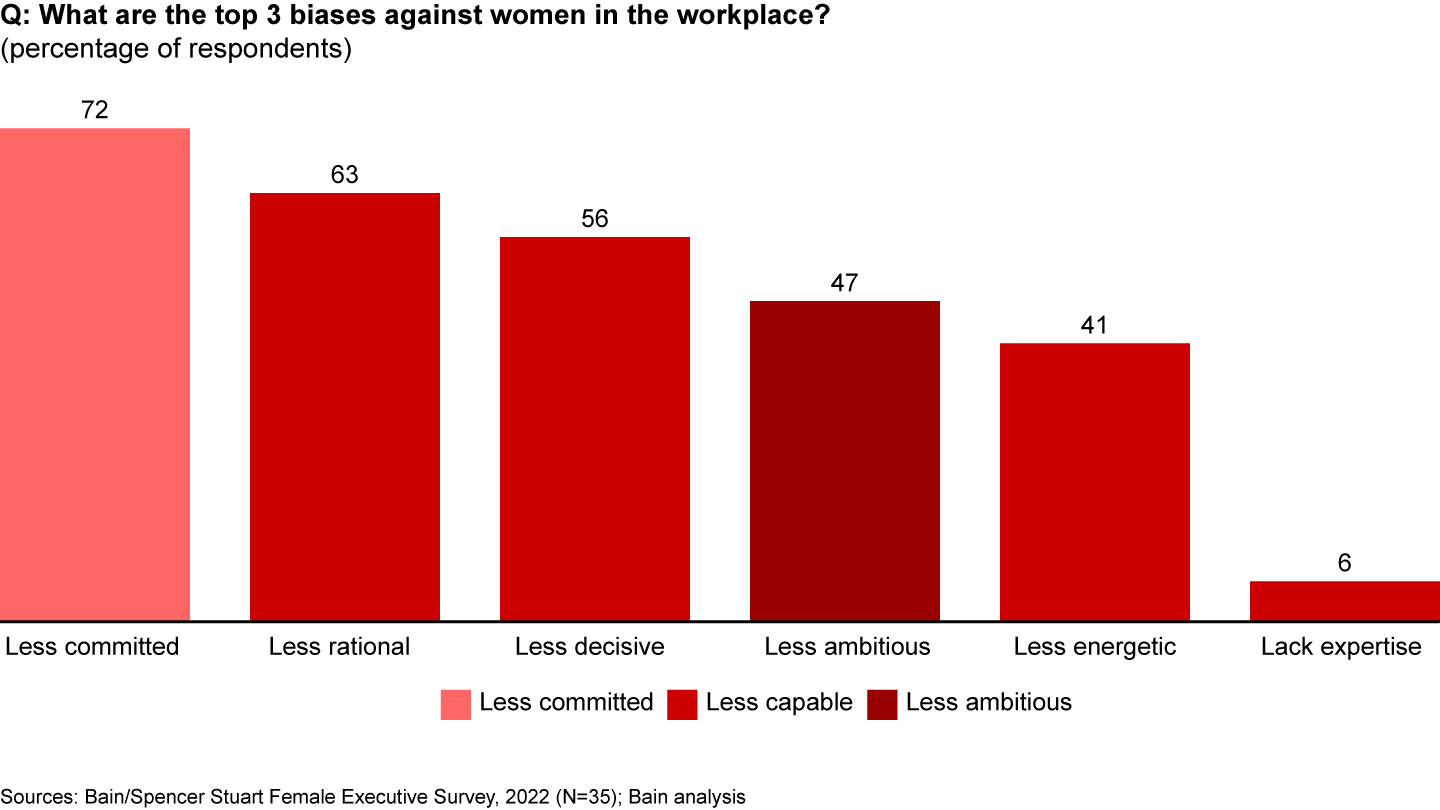
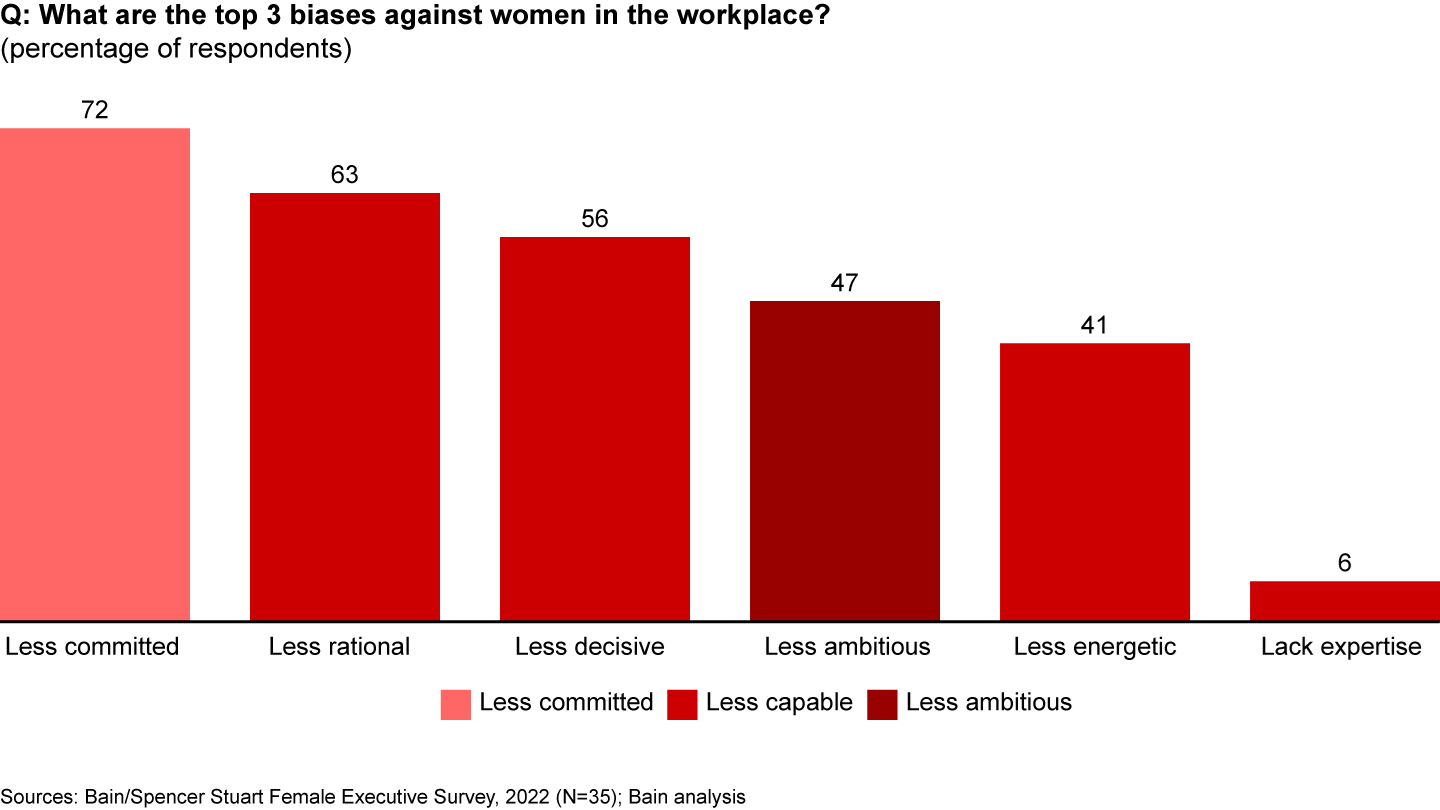
A male COO from an industrial goods company summarized some of this biased thinking. He said, “By default, we think women aren’t capable enough to be the CEO of an industrial goods company. We assume that they’re less effective in building relationships and negotiating.”
As a result of bias, nearly half of the respondents believe they receive fewer challenging tasks and opportunities to develop at their workplace.
Envac China CEO Aiying Wang recalled witnessing bias. When the company hired a program facilitator, a male colleague assumed the supporting role would be filled by a woman. Wang said companies and men are not acting out of malice, but the results are the same. “Unconscious bias partially results in less challenging tasks and fewer opportunities for women,” she said.
“Bias also leads to unfair evaluation of females,” according to Angela Zhu. She said, “When a company wants to promote someone, it’s possible they choose a male candidate rather than a female because of unconscious bias, even if they are equally capable and have demonstrated the same level of performance.”
The women we surveyed agreed. If a man and a woman deliver the same results, women believe the company would favor the man. Forty-seven percent said bias about women “being average” makes it harder for them to receive due recognition.
The “average” bias also limits women’s career potential. Women stop being promoted to CFO and CEO positions around age 50, and leadership is mostly turned over to men (see Figure 10).
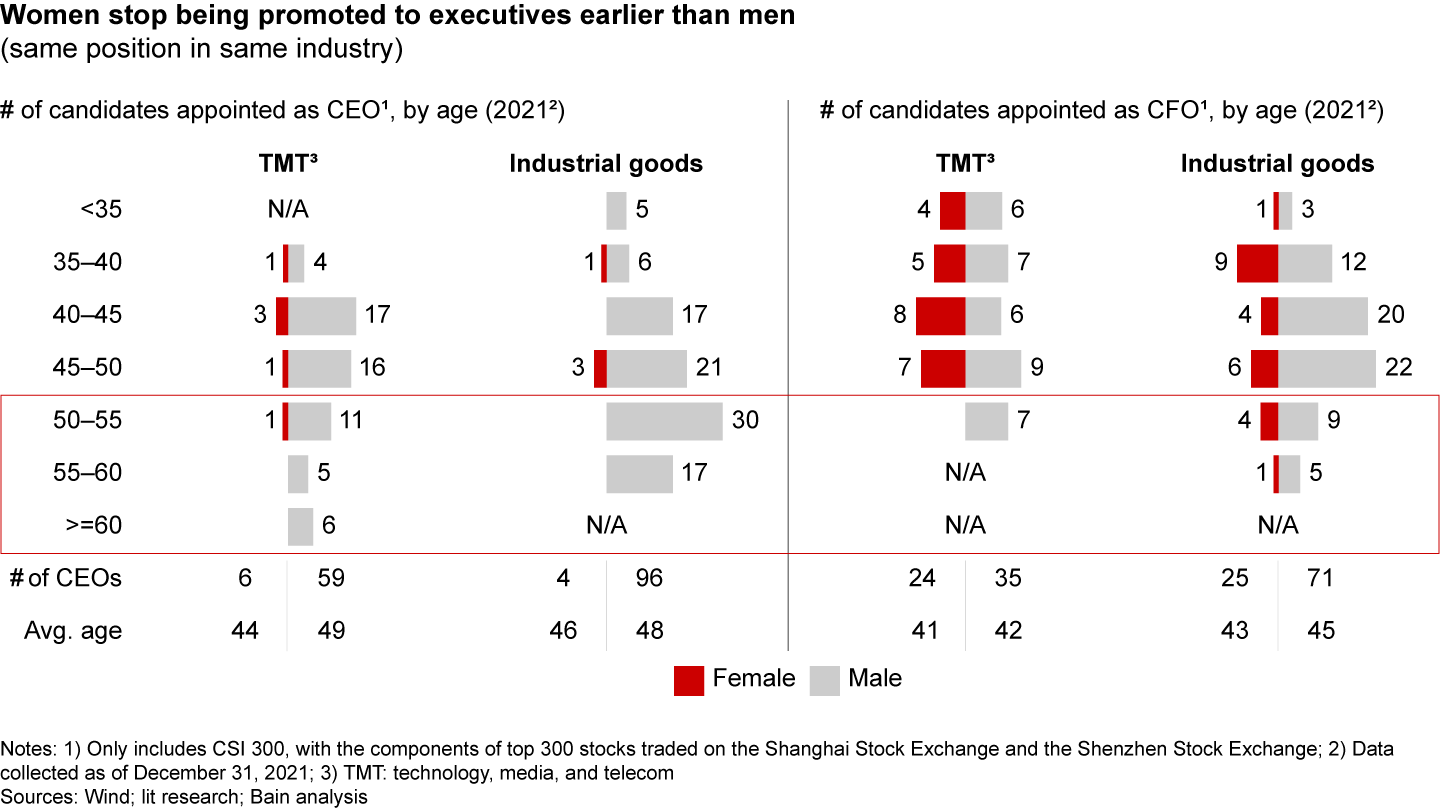
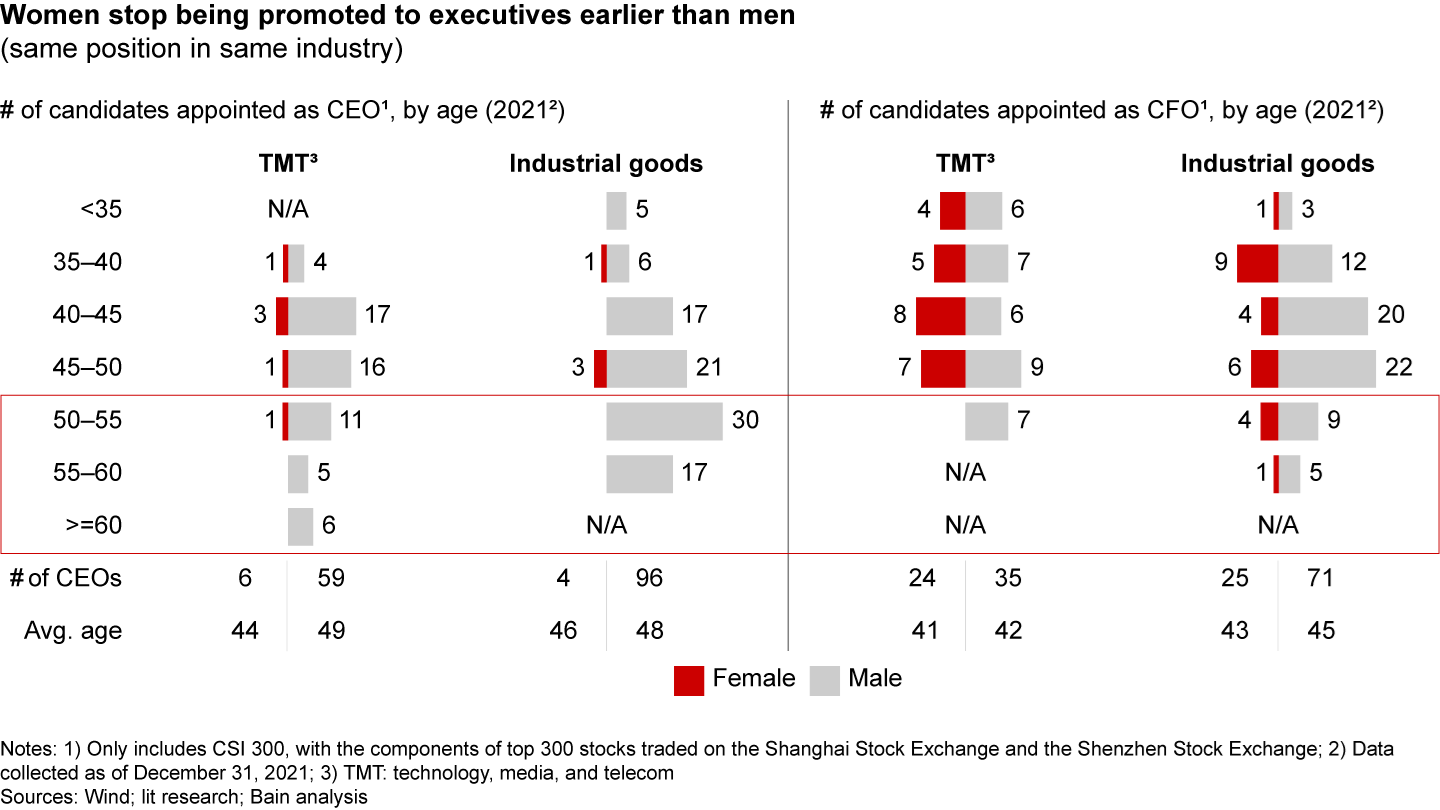
How to unlock women’s leadership potential
With deliberate action, companies and women can overcome these barriers and unlock women’s leadership potential in the workplace (see Figure 11).
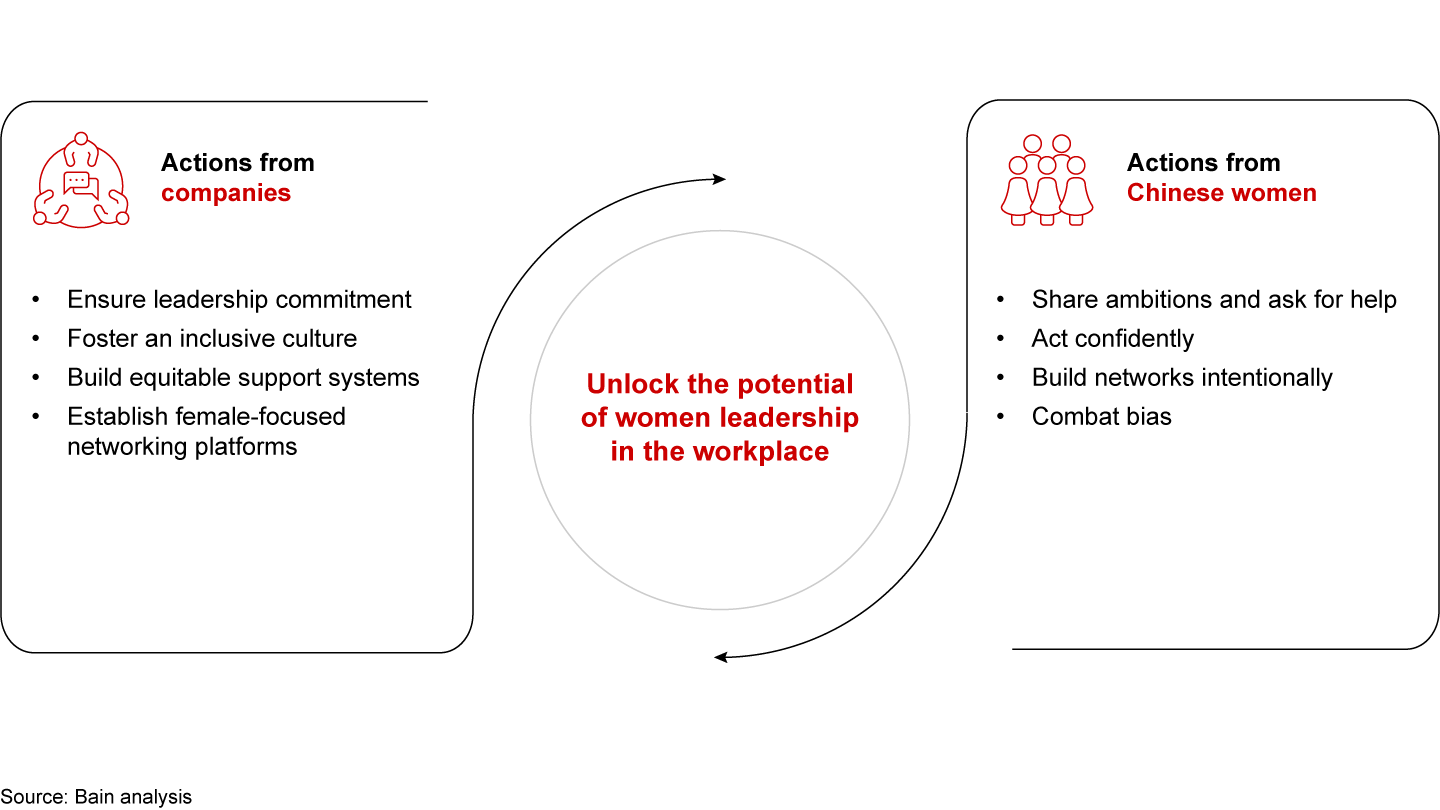
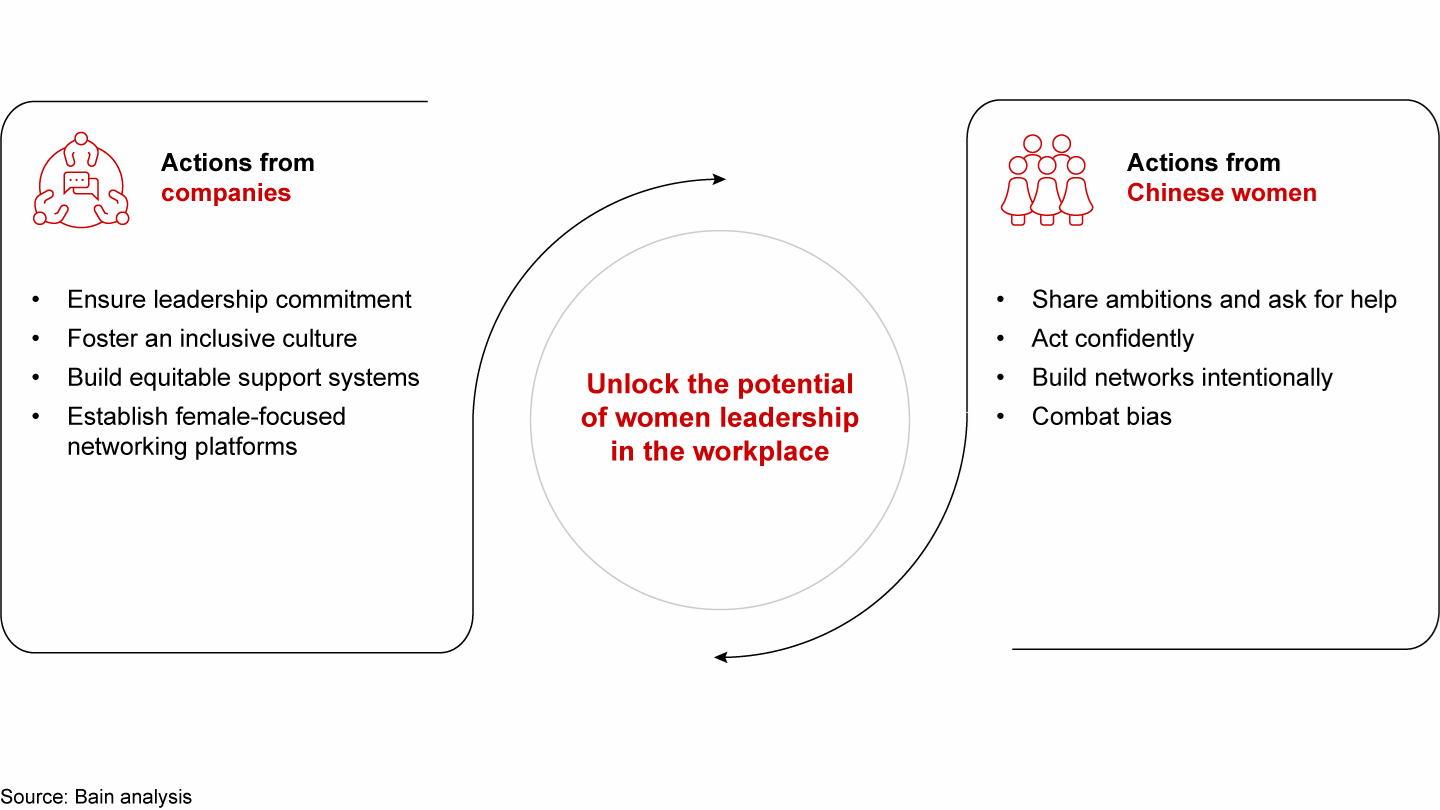
Actions for companies
To thrive, companies in China need to create an equitable environment for men and women. They should:
Ensure leadership commitment. Board members and CEOs need to agree that gender parity is a business priority. Priorities turn into plans, timelines, and goals.
With top-down support, companies can create gender targets for the organization. Targets force leaders to proactively identify high-potential women, develop succession plans for female candidates, and give women more chances to learn and grow.
Companies should also track and share their progress toward gender balance. They can collect data about head counts, hiring decisions, promotions, and exits, and analyze the data by gender. Employee surveys and compensation studies can also illuminate barriers for women.
Foster an inclusive culture. Companies should work to remove unconscious biases and ensure both genders are treated fairly at work, including during selections and performance reviews. Men and women should be compensated equitably for their contributions, too.
Companies should establish clear expectations around inclusive behavior and help employees identify and overcome potential biases. They can also promote female role models and highlight their success to help men and women see past stereotypes.
Build equitable support systems. Because household burdens traditionally fall more heavily on women’s shoulders, women need more help from employers.
Employees at all levels of the organization should be offered and accept family support or flexible working options. When leaders practice family support at scale, it removes stigmas and invites more employees to participate. If men sign on to parental leave and flexible work benefits, they will become more widely accepted.
Establish female-focused networking platforms. To catch up to men, women need more formal pathways to networking, sponsorship, and training.
Roundtables and regular events should feature executive leaders (both male and female) so women gain exposure to higher-level leaders and make connections. Sponsorship and succession planning for women should be systematic and formalized to create pipelines of strong female candidates.
Women will also benefit from training. Networking, relationship-building, and communicating are skill deficits that women believe are holding them back—and can be overcome.
Actions for aspiring women
Share ambitions and ask for help. Women should share their career ambitions with family members and ask for help from spouses and elders. Executive women also propose adopting a new mindset: Instead of sacrificing their careers for family, view women as role models for supporting their families (and communities and the greater economy) through work.
Act confidently. Notice tendencies to avoid risk, back down, or stay quiet—and challenge yourself and other women to speak up. Ask for feedback and support to become more vocal and valuable in meetings. Confidence builds over time with practice and learning. Start speaking up and confidence will follow.
Build networks intentionally. Relationship-building is a skill. With practice, women can learn to build professional relationships in a way that feels natural and comfortable to them. Be intentional when building connections so they lead toward skills development, mentorship, or sponsorship. When given the chance, sponsor and develop other high-potential women. And do not rule out participating in male networks.
Combat bias. Celebrate women’s accomplishments and strengths. If women are treated unfairly at work, confront the behavior. When men and women recognize bias, they can challenge the underlying thinking and change it.
Conclusion
Chinese women have not risen to the top levels of leadership like men have, despite having similar odds at the start of their careers, and their absence is affecting everyone. To improve financial performance, fill critical talent gaps, and advance a host of other metrics, Chinese companies need more women at the helm.
Gender equity will not happen overnight or by accident, especially in industries that are dominated by men today. Acknowledge the gap, then get to work.
Companies can start by establishing a long-term vision with measurable targets. Then, assign leaders and hold them accountable. Ask women for feedback about their experiences. Listen. Analyze. Then act.
On International Women’s Day, and always, we encourage you to recognize and celebrate women who make outstanding contributions and ask you to create opportunities for more women to follow.

At Spencer Stuart, we know how much leadership matters. We are trusted by organizations around the world to help them make the senior-level leadership decisions that have a lasting impact on their enterprises. Through our executive search, board and leadership advisory services, we help build and enhance high-performing teams for select clients ranging from major multinationals to emerging companies to nonprofit institutions. Privately held since 1956, we focus on delivering knowledge, insight and results through the collaborative efforts of a team of experts—now spanning more than 60 offices, over 30 countries and more than 50 practice specialties. Boards and leaders consistently turn to Spencer Stuart to help address their evolving leadership needs in areas such as senior-level executive search, board recruitment, board effectiveness, succession planning, in-depth senior management assessment, employee engagement and many other facets of culture and organizational effectiveness.